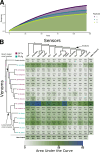Red-on-Yellow Queen: Bio-Layer Interferometry Reveals Functional Diversity Within Micrurus Venoms and Toxin Resistance in Prey Species
- PMID: 38814340
- PMCID: PMC11168994
- DOI: 10.1007/s00239-024-10176-x
Red-on-Yellow Queen: Bio-Layer Interferometry Reveals Functional Diversity Within Micrurus Venoms and Toxin Resistance in Prey Species
Abstract
Snakes in the family Elapidae largely produce venoms rich in three-finger toxins (3FTx) that bind to the subunit of nicotinic acetylcholine receptors (nAChRs), impeding ion channel activity. These neurotoxins immobilize the prey by disrupting muscle contraction. Coral snakes of the genus Micrurus are specialist predators who produce many 3FTx, making them an interesting system for examining the coevolution of these toxins and their targets in prey animals. We used a bio-layer interferometry technique to measure the binding interaction between 15 Micrurus venoms and 12 taxon-specific mimotopes designed to resemble the orthosteric binding region of the muscular nAChR subunit. We found that Micrurus venoms vary greatly in their potency on this assay and that this variation follows phylogenetic patterns rather than previously reported patterns of venom composition. The long-tailed Micrurus tend to have greater binding to nAChR orthosteric sites than their short-tailed relatives and we conclude this is the likely ancestral state. The repeated loss of this activity may be due to the evolution of 3FTx that bind to other regions of the nAChR. We also observed variations in the potency of the venoms depending on the taxon of the target mimotope. Rather than a pattern of prey-specificity, we found that mimotopes modeled after snake nAChRs are less susceptible to Micrurus venoms and that this resistance is partly due to a characteristic tryptophan serine mutation within the orthosteric site in all snake mimotopes. This resistance may be part of a Red Queen arms race between coral snakes and their prey.
Keywords: Arms race; Coral snake; Elapid; Mimotope; Three-finger toxin.
© 2024. The Author(s).
Figures


Similar articles
-
Ancient Diversification of Three-Finger Toxins in Micrurus Coral Snakes.J Mol Evol. 2018 Jan;86(1):58-67. doi: 10.1007/s00239-017-9825-5. Epub 2018 Jan 27. J Mol Evol. 2018. PMID: 29379986
-
New insights into the phylogeographic distribution of the 3FTx/PLA2 venom dichotomy across genus Micrurus in South America.J Proteomics. 2019 May 30;200:90-101. doi: 10.1016/j.jprot.2019.03.014. Epub 2019 Apr 1. J Proteomics. 2019. PMID: 30946991
-
Assessing the Binding of Venoms from Aquatic Elapids to the Nicotinic Acetylcholine Receptor Orthosteric Site of Different Prey Models.Int J Mol Sci. 2020 Oct 6;21(19):7377. doi: 10.3390/ijms21197377. Int J Mol Sci. 2020. PMID: 33036249 Free PMC article.
-
Venoms of Micrurus coral snakes: Evolutionary trends in compositional patterns emerging from proteomic analyses.Toxicon. 2016 Nov;122:7-25. doi: 10.1016/j.toxicon.2016.09.008. Epub 2016 Sep 15. Toxicon. 2016. PMID: 27641749 Review.
-
What Are the Neurotoxins in Hemotoxic Snake Venoms?Int J Mol Sci. 2023 Feb 2;24(3):2919. doi: 10.3390/ijms24032919. Int J Mol Sci. 2023. PMID: 36769242 Free PMC article. Review.
Cited by
-
Make Acetylcholine Great Again! Australian Skinks Evolved Multiple Neurotoxin-Proof Nicotinic Acetylcholine Receptors in Defiance of Snake Venom.Int J Mol Sci. 2025 Aug 4;26(15):7510. doi: 10.3390/ijms26157510. Int J Mol Sci. 2025. PMID: 40806638 Free PMC article.
References
-
- Ávila RW, Kawashita-Ribeiro RA, Ferreira VL, et al. Natural history of the coral snake Micrurus pyrrhocryptus cope 1862 (Elapidae) from semideciduous forests of Western Brazil. South Am J Herpetol. 2010;5(2):97–101. doi: 10.2994/057.005.0204. - DOI
MeSH terms
Substances
Grants and funding
LinkOut - more resources
Full Text Sources

